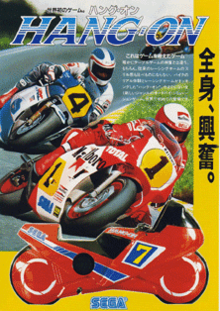Hang-On
| Hang-On | |
|---|---|

Original arcade flyer
|
|
| Developer(s) | Sega AM2 |
| Publisher(s) | Sega |
| Designer(s) | Yu Suzuki |
| Composer(s) |
Arcade Hiroshi Kawaguchi Sega Master System Katsuhiro Hayashi |
| Platform(s) | Arcade, Sega SG-1000, Sega Master System, Sega Saturn, MSX |
| Release | July 1985 |
| Genre(s) | Racing |
| Mode(s) | Single Player |
| Cabinet | Standard and sit-down |
| Arcade system | Sega Hang-On |
| CPU | (2x) 68000 (@ 6 MHz) Sound CPU: Z80 (@ 4 MHz) |
| Sound | YM2203 (@ 4 MHz) Sega PCM (@ 31.25 kHz) |
| Display |
Raster resolution 320×224 pixels (Horizontal), 6144 out of 32,768 colors |
Hang-On (ハングオン Hangu On?) is an arcade game designed by Yu Suzuki and released by Sega in 1985. In the game, the player controls a motorcycle against time and other computer-controlled bikes. It was one of the first arcade games to use 16-bit graphics and Sega's "Super Scaler" technology that allowed pseudo-3D sprite-scaling at high frame rates. It also introduced a motion-controlled arcade cabinet, where the player's body movement on a large motorbike-shaped cabinet corresponds with the player character's movements on screen, inspiring arcade games that followed and anticipating the modern motion control trend.
The game was also built into some versions of the Sega Master System. The title is derived from when the biker is turning and has to "hang on" to the bike while the bike is leaning, which Suzuki had read in a Japanese bike magazine, though Suzuki learned later the technique was called "hang off" in North America. Nevertheless, he chose to keep the former name. In a 1995 interview Suzuki said he felt Hang-On was his most impressive game at the time of release.
Using a behind the motorcycle perspective, the player races a linear race track divided into several stages within a limited time. Reaching a checkpoint at the end of each stage extends the time limit. The game ends if the time runs out.
The arcade game contains in-game billboards for Bridgestone (and their Desert Dueler tires), Shell, Garelli Motorcycles, TAG, John Player Special cigarettes, Forum cigarettes, and for "Marbor", an obvious parody of Marlboro cigarettes. The arcade flyer features a bike in Marlboro colors, who had sponsored the Yamaha YZR500 during the world championships in the mid and late 1980s. There would be a controversy over cigarette ads in games marketed to children upon the release of another Sega racing game, Super Monaco GP in 1989.
...
Wikipedia
